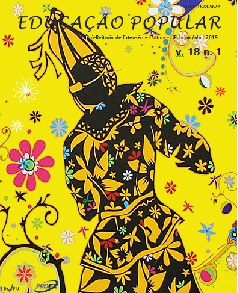Benediction
cultural/religious practice of blessers and traditional midwives in the Macapá, State of Amapá, Brazil
DOI:
https://doi.org/10.14393/rep-v18n12019-45910Keywords:
Traditional Midwives of Amapá, Benediction as Cultural/Religious Practice, Afroindigenous Cultural HeritageAbstract
In this article we will address the benediction, a common practice in the Amazon and in several traditional communities of the State of Amapá. Women called blessers/healers and/or midwives play a fundamental sociocultural and spiritual role in their communities. The present text deals with a qualitative reflective work that used bibliographical research, documentary analysis, direct observation and interview as a form of investigation. The research revealed that the knowledge of blessers/healers and midwives is threatened with extinction in the state of Amapá, because current generations do not show interest in learning this practice of healing. Another threat consists in the change of religion of some of these women and / or relatives, who, when entering the Neo-Pentecostal evangelical churches, abandon their spiritual gift because it is considered a demonic practice in these environments.
Downloads
References
AMAPÁ. Dia Internacional da Parteira. 2018. Disponível em: https://www.portal.ap.gov.br/noticia/0505/dia-internacional-da-parteira-celebra-trabalho-que-salva-vidas. Acesso em: 15 set. 2018.
BOYER, V. Passado português, presente negro e indizibilidade ameríndia: o caso de Mazagão velho, Amapá. Religião e Sociedade, Rio de Janeiro, n. 28, v. 2, p. 11-29, 2008. Doi: 10.1590/S0100-85872008000200002.
BRANDÃO, C. R. Os deuses do povo. São Paulo: Editora S.A., 1980. 302 p.
BRITO, J. F. de L. A Fortaleza de Macapá como monumento e a cidade como documento histórico. 2014. 265 f. Dissertação (Mestrado) – Instituto do Patrimônio Histórico e Artístico Nacional, Mestrado Profissional em Preservação do Patrimônio Cultural, Rio de Janeiro, 2014.
CAVALCANTI, B. C.; FERNANDES, C. S.; BARROS, R. R. de A. (org.) Kulé-Kulé: afroatitudes. Maceió: EDUFAL, 2007.
EHRENREICH, B.; ENGLISH, D. Bruxas, parteiras e enfermeiras: uma história das curandeiras. Traduzido pela Editora Subita, 1973. Disponível em: https://we.riseup.net/saude_autonomia/bruxas-parteiras-e-enfermeiras. Acesso em: 25 abr. 2018.
PACHECO, A. S. Encantarias afroindígenas na Amazônia Marajoara: narrativas, práticas de cura e (in)tolerâncias religiosas. Horizonte (Dossiê: Biodiversidade, Política e Religião), Belo Horizonte, n. 7, p. 88-108, abr./jun. 2010. Doi: 10.5752/P.2175-5841.2010v8n17p88-108.
PACHECO, A. S. Cosmologias afroindígenas na Amazônia Marajoara. Projeto História, São Paulo, n. 44, p. 197-226, jun. 2012. Disponível em: https://revistas.pucsp.br/index.php/revph/article/viewFile/10219/9821. Acesso em: 25 abr. 2018.
LÉVI-STRAUSS, C. Antropologia Estrutural. Rio de Janeiro: Tempo Brasileiro, 1975. 432 p.
NOGUEIRA, L. C.; VERSONITO, S. M.; TRISTÃO, B. D. O dom de benzer: a sobrevivência dos rituais de benzeção nas sociedades urbanas - o caso do Município de Mara Rosa, Goiás, Brasil. Élisée, Goiânia, v. 1, n. 2, p. 167-181, jul./dez., 2012. Disponível em: http://www.revista.ueg.br/index.php/elisee/article/viewFile/1290/693. Acesso em: 25 abr. 2018.
NUNES, A. C. M.; PACHECO, A. S. Arte (manhas) da cultura afroindígena: trajetórias e experiências de Mestre Damasceno pelo Marajó dos Campos. Boitatá, Londrina n. 13, p. 1-19, jun.-jul. 2012. Disponível em: http://revistaboitata.portaldepoeticasorais.inf.br/site/arquivos/revistas/1/augusto%20e%20agenor.pdf. Acesso em: 25 abr. 2018.
OLIVEIRA, E. R. de. O que é benzeção. São Paulo: Brasiliense, 1985. 110 p.
RIBEIRO, P. S. Cultura brasileira: da diversidade à desigualdade. Brasil Escola, 2016. Disponível em: https://brasilescola.uol.com.br/sociologia/cultura-brasileira-diversidade-desigualdade.htm. Acesso em: 15 set. 2018.
Downloads
Published
How to Cite
Issue
Section
License
Copyright (c) 2019 Elivaldo Serrão Custódio, Piedade Lino Videira, Fábio José do Espírito Santo Souza, João Felype Barreto Ferreira

This work is licensed under a Creative Commons Attribution-NonCommercial-NoDerivatives 4.0 International License.
Autores que publicam nesta revista concordam em manter os direitos autorais e conceder à revista o direito de primeira publicação, com o trabalho simultaneamente licenciado sob a Licença Creative Commons Atribuição-NãoComercial-SemDerivações 4.0 Internacional.





